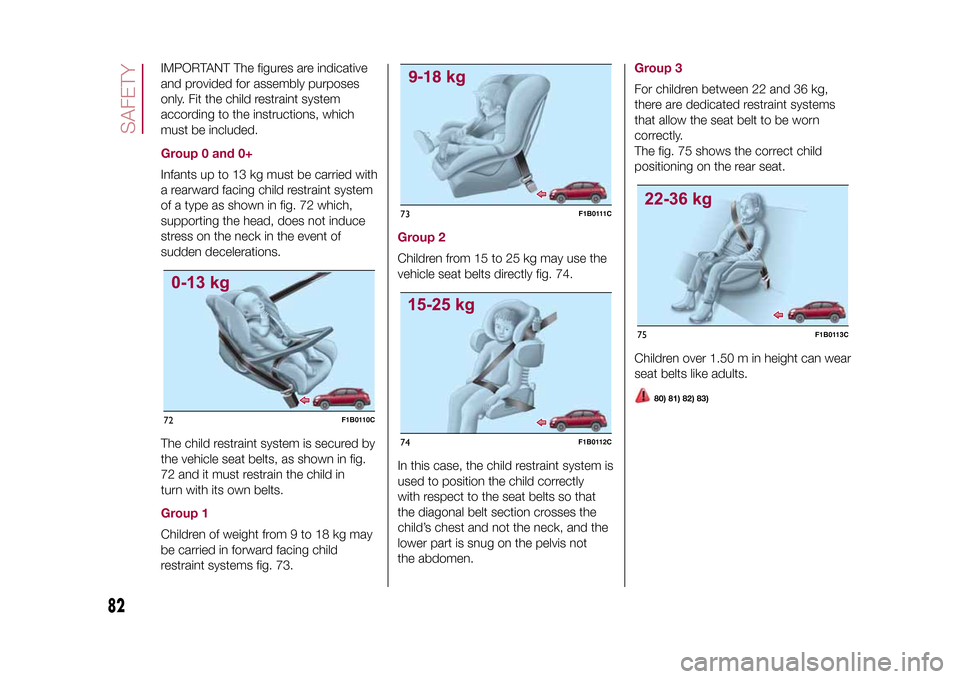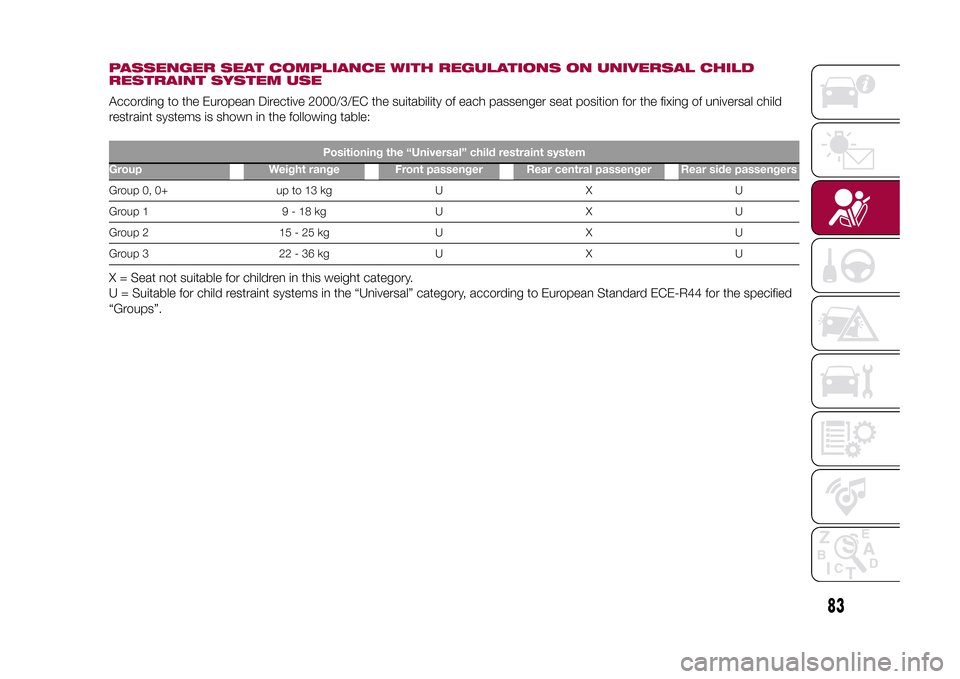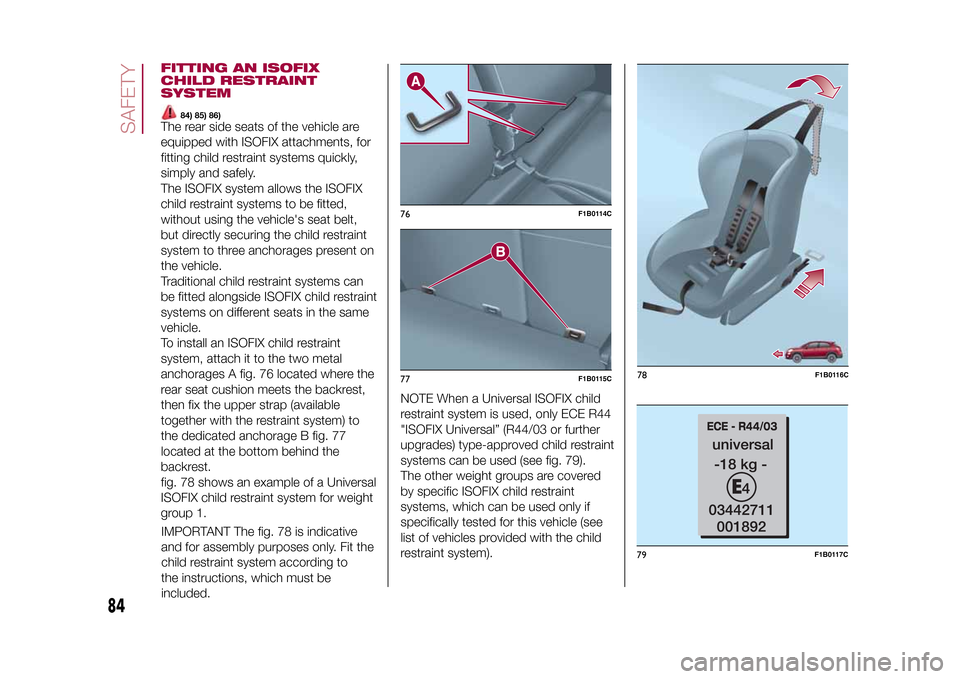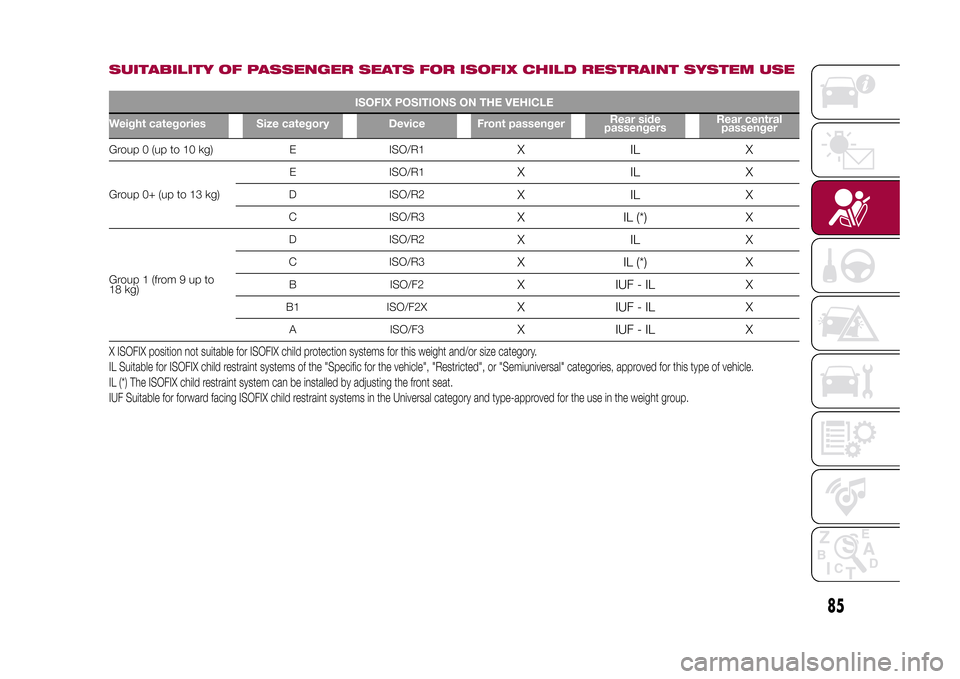2015 FIAT 500X weight
[x] Cancel search: weightPage 26 of 240

❒Position 3: driver + maximum
admissible load stowed only in the
boot.
IMPORTANT Check the headlight
alignment each time the weight of the
load transported changes.INSTRUMENT PANEL AND
CONTROL BUTTON
GRAPHICS BRIGHTNESS
ADJUSTMENTWith side lights or headlights on, turn
ring nut B fig. 29 upwards to increase
light brightness of the instrument panel
and of the control button graphics, or
turn the ring nut downwards to
decrease it.
WARNING
18)The daytime running lights are an
alternative to the dipped beam headlights
for driving in countries where it is
compulsory to have lights on during the
day; where it is not compulsory, the use of
daytime running lights is permitted.
19)Daytime running lights cannot replace
dipped beam headlights when driving at
night or through tunnels. The use of
daytime running lights is governed by the
highway code of the country in which
you are driving. Comply with legal
requirements.
INTERIOR LIGHTSFRONT ROOF LIGHTSwitch A fig. 30 is used to switch on/off
the roof light bulbs.
Switch A positions:
❒central position: lights B and E switch
on/off when the doors are opened/
closed;
❒pressed to the left (OFF): lights B and
E are always switched off;
❒pressed to the right (
): lights B
and E are always switched on.
The lights switch on/off gradually.
Switch C switches light B on/off.
Switch D switches light E on/off.
Roof light timingOn certain versions, to facilitate getting
in/out of the vehicle at night or in
poorly-lit areas, two timed modes have
been provided.
❒Timing while getting into the vehicle
❒Timing while getting out of the
vehicle.
30
F1B0041C
24
GETTING TO KNOW YOUR CAR
15-12-2014 8:23 Pagina 24
Page 39 of 240

The load platform can also be tilted,
and is equipped with a washable plastic
surface, useful for instance for
transporting wet or muddy items.
IMPORTANT Movements of the load
platform must take place in a central
position relative to the boot.
Securing your loadThere are four hooks at the corners of
the boot (two at the front A fig. 49
and two at the rear B), for attaching
cables which can secure the load
carried.
WARNING
27)Be careful not to hit objects on the
storage shelf when you open the tailgate.
WARNING
12)The dimensions of the platform permit
a maximum capacity of distributed weight
of 70 kg: do not load objects with a heavier
weight.
47
F1B0327C
48
F1B0328C
49
F1B0079C
37
15-12-2014 8:23 Pagina 37
Page 68 of 240

55)When towing trailers, the utmost
caution at the wheel is recommended.
Never exceed the maximum permitted
loads (see the description in the "Weights"
paragraph in the "Technical Specifications"
chapter).
56)The TSC system cannot prevent
swerving for all trailers. If the system
activates during driving, reduce the speed,
stop the vehicle in a safe place and arrange
the load correctly to prevent the trailer
from swerving.
DRIVING
ASSISTANCE
SYSTEMSThe vehicle can feature the following
driving assistance systems:
❒BSA (Blind Spot Assist);
❒FBC (Full Brake Control);
❒iTPMS (indirect Tyre Pressure
Monitoring System).
For the operation of the systems, see
the following pages.BSA (Blind Spot Assist)
SYSTEMThe vehicle can be equipped with the
BSA (Blind Spot Assist) system for blind
spot monitoring. The BSA system
uses two radar sensors, located in the
rear bumper (one for each side - see
fig. 55), to detect the presence of
vehicles (vehicles, trucks, motorbikes,
etc.) in the rear side blind spots of
the vehicle.
The system warns the driver about the
presence of vehicles in the detection
area by lighting up, on the relevant side,
the warning light located on the door
mirror fig. 56, along with an acoustic
warning.
When the vehicle is started the warning
light turns on to signal the driver that
the system is active.
55
F1B0093C
56
F1B0094C
66
SAFETY
15-12-2014 8:23 Pagina 66
Page 83 of 240

CHILD PROTECTION
SYSTEMSCARRYING CHILDREN
SAFELY
76) 77) 78) 79)
For optimal protection in the event of an
impact, all occupants must be seated
and wearing adequate restraint
systems, including newborn and other
children!
This prescription is compulsory in all EC
countries according to EC Directive
2003/20/EC.
Children below the height of 1.50
metres and up to 12 years must be
protected with suitable restraint
systems and be seated on the rear
seats.
Statistics on accidents indicate that the
rear seats offer greater safety for
children.
Compared with an adult, a child's head
is larger and heavier in proportion to
their body and the child's muscular and
bone structures are not fully developed.
Therefore, correct restraint systems
other than adult seat belts are
necessary, to reduce as much as
possible the risk of injuries in the event
of an accident, braking or sudden
manoeuvre.Children must be seated safely and
comfortably. Depending on the
characteristics of the child restraint
systems used, you are advised to keep
children in rearward facing child
restraint systems for as long as
possible (at least until 3–4 years old),
since this is the most protected position
in the event of an impact.
The choice of the most suitable child
restraint system depends on the weight
and size of the child. There are various
types of child restraint systems, which
can be secured to the vehicle by means
of the seat belts or with the ISOFIX/i-
Size anchorages.
It is recommended to always choose
the restraint system most suitable
for the child; for this reason always refer
to the Owner Handbook provided with
the child restraint system, to be sure
that it is of the right type for the children
it is intended for.
In Europe the characteristics of child
restraint systems are ruled by the
regulation ECE-R44, dividing them into
five weight groups:
Group Weight rangeGroup0 upto10kg
Group 0+ up to 13 kg
Group 1 9 - 18 kg
Group Weight rangeGroup 2 15 - 25 kg
Group 3 22 - 36 kgThe ECE-R44 standard was recently
paired with the ECE R-129 regulation,
which defines the characteristics of
the new i-Size child restraint systems
(see the "Suitability of passenger seats
for i-Size child restraint system use"
paragraph for more information).
All restraint devices must bear the
certification data, together with the
control mark, on a label solidly fixed to
the child restraint system which must
never be removed.
Lineaccessori MOPAR
®includes child
restraint systems for each weight
group. These devices are
recommended having been specifically
designed for Fiat vehicles.
FITTING A CHILD
RESTRAINT SYSTEM
WITH SEAT BELTSThe Universal child restraint systems
installed with the seat belts only are
type-approved on the basis of the ECE
R44 standard and are divided into
various weight groups.
81
15-12-2014 8:23 Pagina 81
Page 84 of 240

IMPORTANT The figures are indicative
and provided for assembly purposes
only. Fit the child restraint system
according to the instructions, which
must be included.Group 0 and 0+Infants up to 13 kg must be carried with
a rearward facing child restraint system
of a type as shown in fig. 72 which,
supporting the head, does not induce
stress on the neck in the event of
sudden decelerations.
The child restraint system is secured by
the vehicle seat belts, as shown in fig.
72 and it must restrain the child in
turn with its own belts.Group 1Children of weight from 9 to 18 kg may
be carried in forward facing child
restraint systems fig. 73.
Group 2Children from 15 to 25 kg may use the
vehicle seat belts directly fig. 74.
In this case, the child restraint system is
used to position the child correctly
with respect to the seat belts so that
the diagonal belt section crosses the
child’s chest and not the neck, and the
lower part is snug on the pelvis not
the abdomen.
Group 3For children between 22 and 36 kg,
there are dedicated restraint systems
that allow the seat belt to be worn
correctly.
The fig. 75 shows the correct child
positioning on the rear seat.
Children over 1.50 m in height can wear
seat belts like adults.
80) 81) 82) 83)
72
F1B0110C
73
F1B0111C
74
F1B011 2C
75
F1B0113C
82
SAFETY
15-12-2014 8:23 Pagina 82
Page 85 of 240

PASSENGER SEAT COMPLIANCE WITH REGULATIONS ON UNIVERSAL CHILD
RESTRAINT SYSTEM USEAccording to the European Directive 2000/3/EC the suitability of each passenger seat position for the fixing of universal child
restraint systems is shown in the following table:
Positioning the “Universal” child restraint system
Group Weight range Front passenger Rear central passenger Rear side passengers
Group 0, 0+ up to 13 kg U X U
Group 1 9 - 18 kg U X U
Group 2 15 - 25 kg U X U
Group 3 22 - 36 kg U X UX = Seat not suitable for children in this weight category.
U = Suitable for child restraint systems in the “Universal” category, according to European Standard ECE-R44 for the specified
“Groups”.
83
15-12-2014 8:23 Pagina 83
Page 86 of 240

FITTING AN ISOFIX
CHILD RESTRAINT
SYSTEM
84) 85) 86)
The rear side seats of the vehicle are
equipped with ISOFIX attachments, for
fitting child restraint systems quickly,
simply and safely.
The ISOFIX system allows the ISOFIX
child restraint systems to be fitted,
without using the vehicle's seat belt,
but directly securing the child restraint
system to three anchorages present on
the vehicle.
Traditional child restraint systems can
be fitted alongside ISOFIX child restraint
systems on different seats in the same
vehicle.
To install an ISOFIX child restraint
system, attach it to the two metal
anchorages A fig. 76 located where the
rear seat cushion meets the backrest,
then fix the upper strap (available
together with the restraint system) to
the dedicated anchorage B fig. 77
located at the bottom behind the
backrest.
fig. 78 shows an example of a Universal
ISOFIX child restraint system for weight
group 1.
IMPORTANT The fig. 78 is indicative
and for assembly purposes only. Fit the
child restraint system according to
the instructions, which must be
included.NOTE When a Universal ISOFIX child
restraint system is used, only ECE R44
"ISOFIX Universal” (R44/03 or further
upgrades) type-approved child restraint
systems can be used (see fig. 79).
The other weight groups are covered
by specific ISOFIX child restraint
systems, which can be used only if
specifically tested for this vehicle (see
list of vehicles provided with the child
restraint system).
76
F1B0114C
77
F1B0115C
78
F1B0116C
84
SAFETY
15-12-2014 8:23 Pagina 84
79
F1B0117C
Page 87 of 240

SUITABILITY OF PASSENGER SEATS FOR ISOFIX CHILD RESTRAINT SYSTEM USE
ISOFIX POSITIONS ON THE VEHICLE
Weight categories Size category Device Front passengerRear side
passengersRear central
passenger
Group 0 (up to 10 kg) E ISO/R1
XILX
Group 0+ (up to 13 kg)E ISO/R1
XILX
D ISO/R2
XILX
C ISO/R3
X IL (*) X
Group 1 (from 9 up to
18 kg)D ISO/R2
XILX
C ISO/R3
X IL (*) X
B ISO/F2
X IUF-IL X
B1 ISO/F2X
X IUF-IL X
A ISO/F3
X IUF-IL X
X ISOFIX position not suitable for ISOFIX child protection systems for this weight and/or size category.
IL Suitable for ISOFIX child restraint systems of the "Specific for the vehicle", "Restricted", or "Semiuniversal" categories, approved for this type of vehicle.
IL (*) The ISOFIX child restraint system can be installed by adjusting the front seat.
IUF Suitable for forward facing ISOFIX child restraint systems in the Universal category and type-approved for the use in the weight group.
85
15-12-2014 8:23 Pagina 85